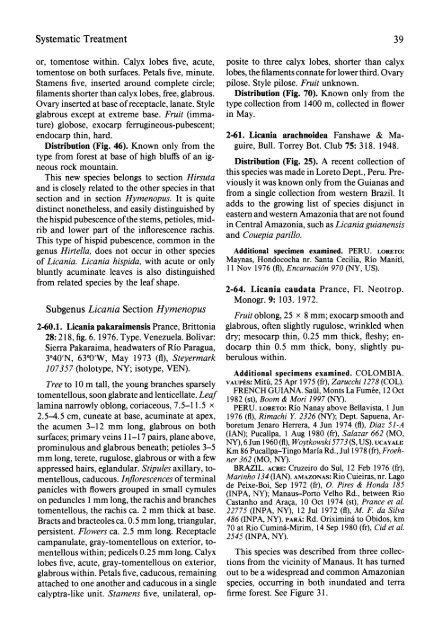flora neotropica - CNCFlora
flora neotropica - CNCFlora
flora neotropica - CNCFlora
You also want an ePaper? Increase the reach of your titles
YUMPU automatically turns print PDFs into web optimized ePapers that Google loves.
Systematic Treatment 39<br />
or, tomentose within. Calyx lobes five, acute,<br />
tomentose on both surfaces. Petals five, minute.<br />
Stamens five, inserted around complete circle;<br />
filaments shorter than calyx lobes, free, glabrous.<br />
Ovary inserted at base of receptacle, lanate. Style<br />
glabrous except at extreme base. Fruit (immaposite<br />
to three calyx lobes, shorter than calyx<br />
lobes, the filaments connate for lower third. Ovary<br />
pilose. Style pilose. Fruit unknown.<br />
Distribution (Fig. 70). Known only from the<br />
type collection from 1400 m, collected in flower<br />
in May.<br />
ture) globose, exocarp ferrugineous-pubescent;<br />
endocarp thin, hard.<br />
2-61. Licania arachnoidea Fanshawe & Ma-<br />
Distribution (Fig. 46). Known only from the<br />
type from forest at base of high bluffs of an igneous<br />
rock mountain.<br />
This new species belongs to section Hirsuta<br />
and is closely related to the other species in that<br />
section and in section Hymenopus. It is quite<br />
distinct nonetheless, and easily distinguished by<br />
the hispid pubescence of the stems, petioles, midrib<br />
and lower part of the inflorescence rachis.<br />
This type of hispid pubescence, common in the<br />
genus Hirtella, does not occur in other species<br />
of Licania. Licania hispida, with acute or only<br />
bluntly acuminate leaves is also distinguished<br />
from related species by the leaf shape.<br />
guire, Bull. Torrey Bot. Club 75: 318. 1948.<br />
Distribution (Fig. 25). A recent collection of<br />
this species was made in Loreto Dept., Peru. Previously<br />
it was known only from the Guianas and<br />
from a single collection from western Brazil. It<br />
adds to the growing list of species disjunct in<br />
eastern and western Amazonia that are not found<br />
in Central Amazonia, such as Licania guianensis<br />
and Couepia parillo.<br />
Additional specimen examined. PERU. LORETO:<br />
Maynas, Hondococha nr. Santa Cecilia, Rio Maniti,<br />
11 Nov 1976 (fl), Encarnaci6n 970 (NY, US).<br />
2-64. Licania caudata Prance, Fl. Neotrop.<br />
Monogr. 9: 103. 1972.<br />
Subgenus Licania Section Hymenopus<br />
2-60.1. Licania pakaraimensis Prance, Brittonia<br />
28:218, fig. 6. 1976. Type. Venezuela. Bolivar:<br />
Sierra Pakaraima, headwaters of Rio Paragua,<br />
3?40'N, 63?0'W, May 1973 (fl), Steyermark<br />
107357 (holotype, NY; isotype, VEN).<br />
Fruit oblong, 25 x 8 mm; exocarp smooth and<br />
glabrous, often slightly rugulose, wrinkled when<br />
dry; mesocarp thin, 0.25 mm thick, fleshy; en-<br />
docarp thin 0.5 mm thick, bony, slightly pu-<br />
berulous within.<br />
Additional specimens examined. COLOMBIA.<br />
Tree to 10 m tall, the young branches VAUPES:<br />
sparsely Mitfi, 25 Apr 1975 (fr), Zarucchi 1278 (COL).<br />
FRENCH GUIANA.<br />
tomentellous, soon glabrate and lenticellate. Saul, Monts La Fumee, 12 Oct<br />
Leaf 1982 (st), Boom & Mori 1997 (NY).<br />
lamina narrowly oblong, coriaceous, 7.5-11.5 x PERU. LORETO: Rio Nanay above Bellavista, 1 Jun<br />
2.5-4.5 cm, cuneate at base, acuminate at apex, 1976 (fl), Rimachi Y. 2326 (NY); Dept. Sapuena, Arthe<br />
acumen 3-12 mm long, glabrous on both boretum Jenaro Herrera, 4 Jun 1974 (fl), Diaz 51-A<br />
surfaces; primary veins 11-17 pairs, plane above, (IAN); Pucallpa, 1 Aug 1980 (fr), Salazar 662 (MO,<br />
prominulous and glabrous beneath; petioles 3-5<br />
NY), 6 Jun 1960 (fl), Woytkowski 5773 (S, US). UCAYALI:<br />
Km 86 Pucallpa-Tingo Maria Rd., Jul 1978 (fr), Froehmm<br />
long, terete, rugulose, glabrous or with a few ner 362 (MO, NY).<br />
appressed hairs, eglandular. Stipules axillary, to- BRAZIL. ACRE: Cruzeiro do Sul, 12 Feb 1976 (fr),<br />
mentellous, caducous. Inflorescences of terminal Marinho 134 (IAN). AMAZONAS: Rio Cuieiras, nr. Lago<br />
de<br />
panicles with flowers grouped in small Peixe-Boi, Sep 1972 (fr), O. Pires & Honda 185<br />
cymules<br />
(INPA, NY); Manaus-Porto Velho Rd., between Rio<br />
on peduncles 1 mm long, the rachis and branches Castanho and Araca, 10 Oct 1974 (st), Prance et al.<br />
tomentellous, the rachis ca. 2 mm thick at base. 22775 (INPA, NY), 12 Jul 1972 (fl), M. F. da Silva<br />
Bracts and bracteoles ca. 0.5 mm long, triangular, 486 (INPA, NY). PARA: Rd. Oriximina to Obidos, km<br />
persistent. Flowers ca. 2.5 mm 70 at Rio<br />
long. Receptacle<br />
Cumina-Mirim, 14 Sep 1980 (fr), Cid et al.<br />
2545 (INPA, NY).<br />
campanulate, gray-tomentellous on exterior, tomentellous<br />
within; pedicels 0.25 mm long. Calyx This species was described from three colleclobes<br />
five, acute, gray-tomentellous on exterior, tions from the vicinity of Manaus. It has turned<br />
glabrous within. Petals five, caducous, remaining out to be a widespread and common Amazonian<br />
attached to one another and caducous in a single species, occurring in both inundated and terra<br />
calyptra-like unit. Stamens five, unilateral, op- firme forest. See Figure 31.

















